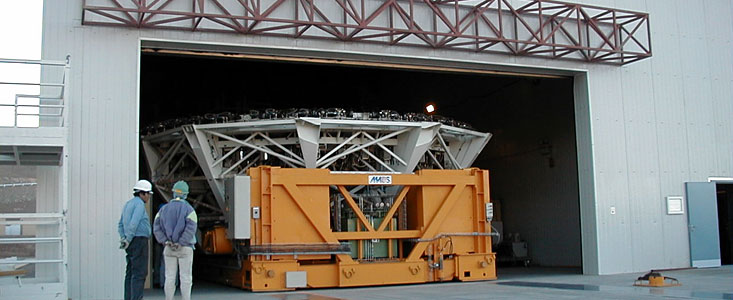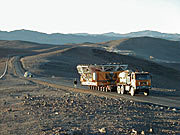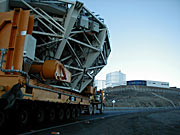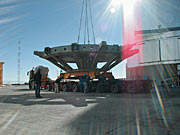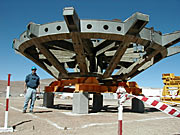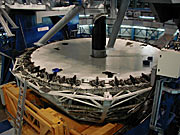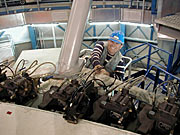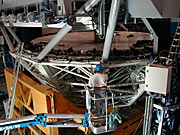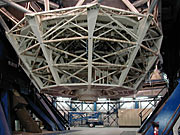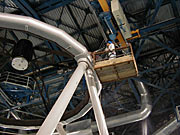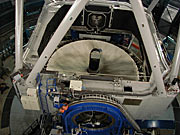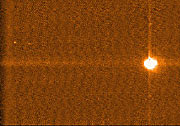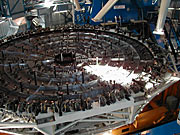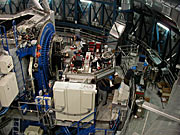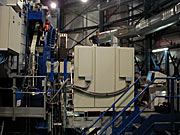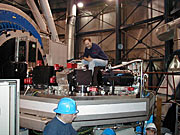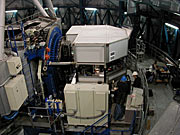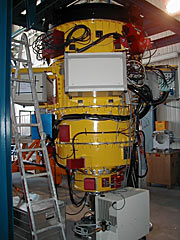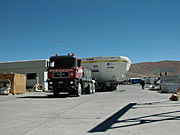Lehdistötiedote
Recent VLT Progress
17. syyskuuta 1999
Work is progressing well at ESO's Very Large Telescope (VLT) project, both at the Paranal Observatory and in Europe. Here is a brief summary with recent news from this major project, illustrated with photos from the construction.
It is now almost half a year since the first 8.2-m VLT Unit Telescope (ANTU) was handed over to the astronomers and it continues to deliver excellent observational data. Several research projects for which time was allocated during the past months have reported very good, sometimes spectacular, results. In some cases, the data have already been fully reduced and the astronomers involved are now in the final stages of preparing the associated scientific reports and papers. It is the intention to present some of the new findings from the VLT in a number of ESO Press Releases during the next months.
Following "First Light" in March this year, the commissioning work for the second Unit Telescope (KUEYEN) successfully reached the stage when instruments could be integrated at the different telescope foci. The next major activity, now underway, is the mounting of the large, high-dispersion spectrograph UVES on one of the Nasmyth platforms. UVES is the second major VLT instrument to be built at ESO - it is also one of the heaviest and most complex ones at this astronomical facility.
This delicate work includes the installation and exceedingly accurate alignment of the many optical components on the heavy baseplate, necessary to ensure the highest optical quality during the forthcoming observations. The moment of "UVES First Light" is approaching, with the first test observations of spectra of celestial objects expected in a few weeks from now.
Work on the assembly of FORS2 continued at the Integration Laboratory in the Mirror Maintenance Building (MMB) and the first tests were made. This instrument will be installed at the Cassegrain focus of KUEYEN in late October 1999.
The dummy M1 Mirror Cell was removed in early August from the third Unit Telescope (MELIPAL) and the real Mirror Cell (the third "M1 Cell"), although still with a concrete (dummy) mirror, was installed at the telescope. With a dummy M2 Unit in place at the top of the telescope frame, pointing and tracking tests were initiated. The first image with the guide 20-cm telescope, mounted on the centrepiece and used for these tests, was obtained in late August. As was the case for the first two Unit Telescopes, the mechanical quality of MELIPAL was found to be excellent and the pointing has now been tuned to a few arcsec over the entire sky. The tracking is also very good.
Following these tests, the M1 Cell was again taken down to the MMB at the Base Camp and the dummy concrete mirror was removed. The M1 Cell was moved back up the mountain and stored under the MELIPAL structure until the (third) 8.2-m Zerodur mirror will be installed in mid-November. "First light" with the VLT Test Camera at the Cassegrain focus of this telescope is planned for February 2000.
The fourth Unit Telescope (YEPUN) is now in the final phase of mechanical assembly. Acceptance tests with the supplier with start soon, after which the construction of the four telescope structures will have been finished. The fourth M1 Cell arrived at Paranal in late August. "First Light" for YEPUN is scheduled for July 2000.
The excavation work for the Paranal Residencia proceeds according to schedule, with the first concrete to be cast shortly.
In Europe, major achievements occurred in the area of the VLT Interferometer (VLTI) construction. ESO concluded a contract with REOSC (France) for delivery of all mirrors to equip the four VLT Unit Telescopes with coude foci optics. An important milestone was reached with the completion of the polishing of the optics for the first delay line for the VLTI at REOSC . The integration of the cat's eye will be done at TNO (Nertherlands) and this part will then be integrated into the delay line at Fokker Aerospace (The Netherlands). Shipment to Chile will take place immediately thereafter.
In addition, the 1.8-m primary mirror for the first VLTI Auxiliary Telescope has reached the final stage of the light-weighting process and the optical polishing will soon begin at AMOS (Belgium).
The following digital photos were obtained during August and September 1999 at Paranal and illustrate the developments there.
MELIPAL M1 Mirror Cell and Pointing/Tracking Tests
KUEYEN Astronomical Instruments
YEPUN Mirror Cell Arrives
Tiedotteesta
| Tiedote nr.: | eso9943 |
| Legacy ID: | Photo 36a-v/99 |
| Nimi: | First Light, FORS2, Mirror, UVES, Very Large Telescope |
| Tyyppi: | Unspecified : Star Unspecified : Technology : Observatory : Facility Unspecified : Technology : Observatory : Telescope |
| Facility: | Very Large Telescope |
Our use of Cookies
We use cookies that are essential for accessing our websites and using our services. We also use cookies to analyse, measure and improve our websites’ performance, to enable content sharing via social media and to display media content hosted on third-party platforms.
ESO Cookies Policy
The European Organisation for Astronomical Research in the Southern Hemisphere (ESO) is the pre-eminent intergovernmental science and technology organisation in astronomy. It carries out an ambitious programme focused on the design, construction and operation of powerful ground-based observing facilities for astronomy.
This Cookies Policy is intended to provide clarity by outlining the cookies used on the ESO public websites, their functions, the options you have for controlling them, and the ways you can contact us for additional details.
What are cookies?
Cookies are small pieces of data stored on your device by websites you visit. They serve various purposes, such as remembering login credentials and preferences and enhance your browsing experience.
Categories of cookies we use
Essential cookies (always active): These cookies are strictly necessary for the proper functioning of our website. Without these cookies, the website cannot operate correctly, and certain services, such as logging in or accessing secure areas, may not be available; because they are essential for the website’s operation, they cannot be disabled.
Functional Cookies: These cookies enhance your browsing experience by enabling additional features and personalization, such as remembering your preferences and settings. While not strictly necessary for the website to function, they improve usability and convenience; these cookies are only placed if you provide your consent.
Analytics cookies: These cookies collect information about how visitors interact with our website, such as which pages are visited most often and how users navigate the site. This data helps us improve website performance, optimize content, and enhance the user experience; these cookies are only placed if you provide your consent. We use the following analytics cookies.
Matomo Cookies:
This website uses Matomo (formerly Piwik), an open source software which enables the statistical analysis of website visits. Matomo uses cookies (text files) which are saved on your computer and which allow us to analyze how you use our website. The website user information generated by the cookies will only be saved on the servers of our IT Department. We use this information to analyze www.eso.org visits and to prepare reports on website activities. These data will not be disclosed to third parties.
On behalf of ESO, Matomo will use this information for the purpose of evaluating your use of the website, compiling reports on website activity and providing other services relating to website activity and internet usage.
Matomo cookies settings:
Additional Third-party cookies on ESO websites: some of our pages display content from external providers, e.g. YouTube.
Such third-party services are outside of ESO control and may, at any time, change their terms of service, use of cookies, etc.
YouTube: Some videos on the ESO website are embedded from ESO’s official YouTube channel. We have enabled YouTube’s privacy-enhanced mode, meaning that no cookies are set unless the user actively clicks on the video to play it. Additionally, in this mode, YouTube does not store any personally identifiable cookie data for embedded video playbacks. For more details, please refer to YouTube’s embedding videos information page.
Cookies can also be classified based on the following elements.
Regarding the domain, there are:
- First-party cookies, set by the website you are currently visiting. They are stored by the same domain that you are browsing and are used to enhance your experience on that site;
- Third-party cookies, set by a domain other than the one you are currently visiting.
As for their duration, cookies can be:
- Browser-session cookies, which are deleted when the user closes the browser;
- Stored cookies, which stay on the user's device for a predetermined period of time.
How to manage cookies
Cookie settings: You can modify your cookie choices for the ESO webpages at any time by clicking on the link Cookie settings at the bottom of any page.
In your browser: If you wish to delete cookies or instruct your browser to delete or block cookies by default, please visit the help pages of your browser:
Please be aware that if you delete or decline cookies, certain functionalities of our website may be not be available and your browsing experience may be affected.
You can set most browsers to prevent any cookies being placed on your device, but you may then have to manually adjust some preferences every time you visit a site/page. And some services and functionalities may not work properly at all (e.g. profile logging-in, shop check out).
Updates to the ESO Cookies Policy
The ESO Cookies Policy may be subject to future updates, which will be made available on this page.
Additional information
For any queries related to cookies, please contact: pdprATesoDOTorg.
As ESO public webpages are managed by our Department of Communication, your questions will be dealt with the support of the said Department.
